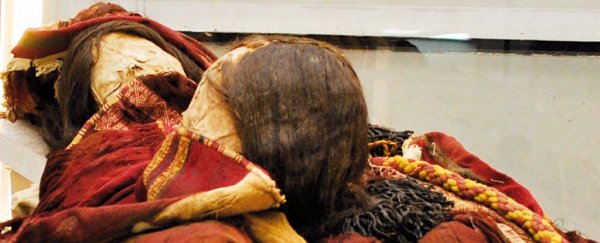Around 500 or 600 years ago, two young girls, aged roughly 9 and 18 years, were buried in the finest of Incan style in Northern Chile. Their grave goods were rich and abundant; their burial clothes coloured the deepest red - and a heavy sprinkling, researchers have now found, of the toxic pigment cinnabar.
It's the first time the substance - the brilliant red form of mercury sulfide - has been associated with a burial from the region.
First discovered in 1976 in Cerro Esmeralda, the mummified remains and their unusual interment have been the subject of many studies over the years. Previous research has determined that the two girls, dated to around 1399-1475 CE, were victims of capacocha, or Qhapaq Hucha - ritual sacrifice.
The practice, which first started at the capital city of Cusco some 1,200 kilometres (745 miles) from where the girls were found, was usually carried out on children, to commemorate important life events of the Incan emperor, to stop natural disasters, or for religious ceremonies.
By the abundance and quality of the grave goods found buried with the two girls, it's believed that the sacrifice was a significant one. And according to Jorge Checura, the researcher who first described the burial, the girls had travelled all the way from Cusco, where the grave goods were from - a trip that would have taken several months.
The presence of cinnabar is another oddity. Checura had also noted that there was a bright red powder in the clothing of one of the two girls, stating that it was cinnabar. However, in northern Chile, hematite is more commonly used, popular for its brilliant red pigment and its opacity.
This new research, conducted by researchers at the University of Tarapacá in Chile, is the first to chemically and microscopically analyse the substance. And, surprisingly - if only because it marks the first time the pigment appears - Checura was correct.
"The new chemical analyses that we obtained showed that cinnabar was present in the clothes of the Cerro Esmeralda mummies," the researchers wrote in their paper.
"This toxic material is a special and foreign funerary offering in northern Chile."
Why it was put there is not clear. It could have been used, as it had been in other societies, such as ancient Rome and Ethiopia, to dye faces and bodies. However, the girls' skin had not been coloured.
If the Incas had known of the substance's toxic properties, the researchers suggest, it could have been sprinkled as a deterrent or punishment for grave robbers - inhaled cinnabar dust has been known to cause mercury poisoning.
But there is one big clue as to why the cinnabar was sprinkled in the grave - its provenance.
There's only one known and proven archaeological source for cinnabar during the Inca Empire, and that's the Huancavelica mine north of Lima, which was also a long distance from the burial site.
"The Incas - and, in general, all the societies that supplied themselves with cinnabar from Huancavelica - always used this mineral in prestigious and elite social contexts," the researchers wrote in their paper.
This prestige is very possibly the reason it was included in a grave that has already been acknowledged as high status.
And the provenance of the girls, the grave goods and the cinnabar also point to a possible reason for the sacrifice - to celebrate the local people coming under the umbrella of the Tawantinsuyo Empire.
"During Inca times, the provinces of the Tawantinsuyo were socially and politically linked to the capital, Cusco, through capacocha rituals that took place on Andean mountains," the researchers noted.
But they also include a note of caution to other archaeologists and anthropologists. The discovery of such a toxic substance so far from its only known source was an unexpected one. Museum workers should, they said, always be careful and take the proper precautions when working with red pigments.
The research has been published in the journal Archaeometry.
